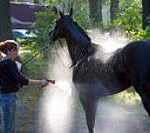Recent research suggests a cure for equine anhidrosis, tying-up and more, based on findings that such negative effects on horse health result when electrolytes don’t always perform as they’re supposed to.
Mesa, AZ (Apr. 26, 2011) – Electrolytes are involved in every physiological process in the horse’s body including hydration, blood pH and maintaining normal muscle function. The typical equine diet of hay and grain usually provides all the electrolytes a horse needs but good health depends on how those electrolytes are balanced.
Researchers are now focusing more attention on electrolyte activity, rather than just level. When comparing healthy horses to unhealthy ones, they’ve found that simply providing electrolytes does not guarantee they’ll work properly. Abnormalities in electrolyte activity have been linked to tying-up and equine anhidrosis.
In Veterinary Dermatology [1], researchers from Glasgow Caledonian University and Michigan State University published findings that anhidrotic horses secrete chloride ions differently than normal, healthy horses do. Defective electrolyte transport mechanisms in the gland are likely responsible.
Continue reading Electrolytes: Why Optimal Horse Health Hangs in the Balance, Not the Quantity
